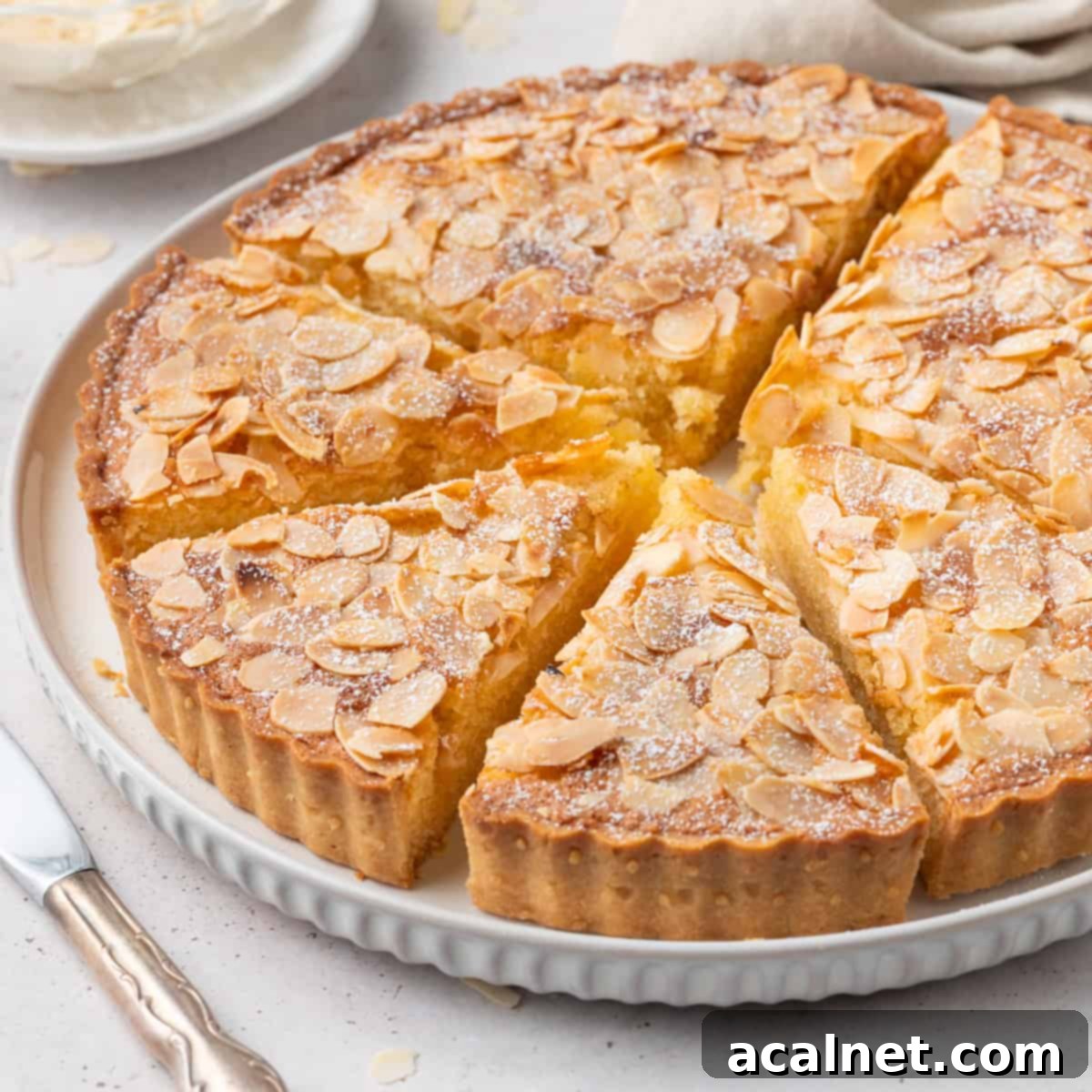Irresistible French Almond Tart (Tarte Amandine): A Classic Recipe Guide
This exquisite French Almond Tart, known in France as Tarte Amandine, is a true masterpiece of simple elegance. It masterfully combines a perfectly crispy Pâte Sucrée crust with a lusciously spongy almond cream (frangipane) filling and a generous scattering of crunchy flaked almonds. If you’re a devotee of almond desserts, from the humble almond croissant to more sophisticated pastries, this recipe is your gateway to baking a fancy yet surprisingly easy treat that will delight your senses and impress your guests.
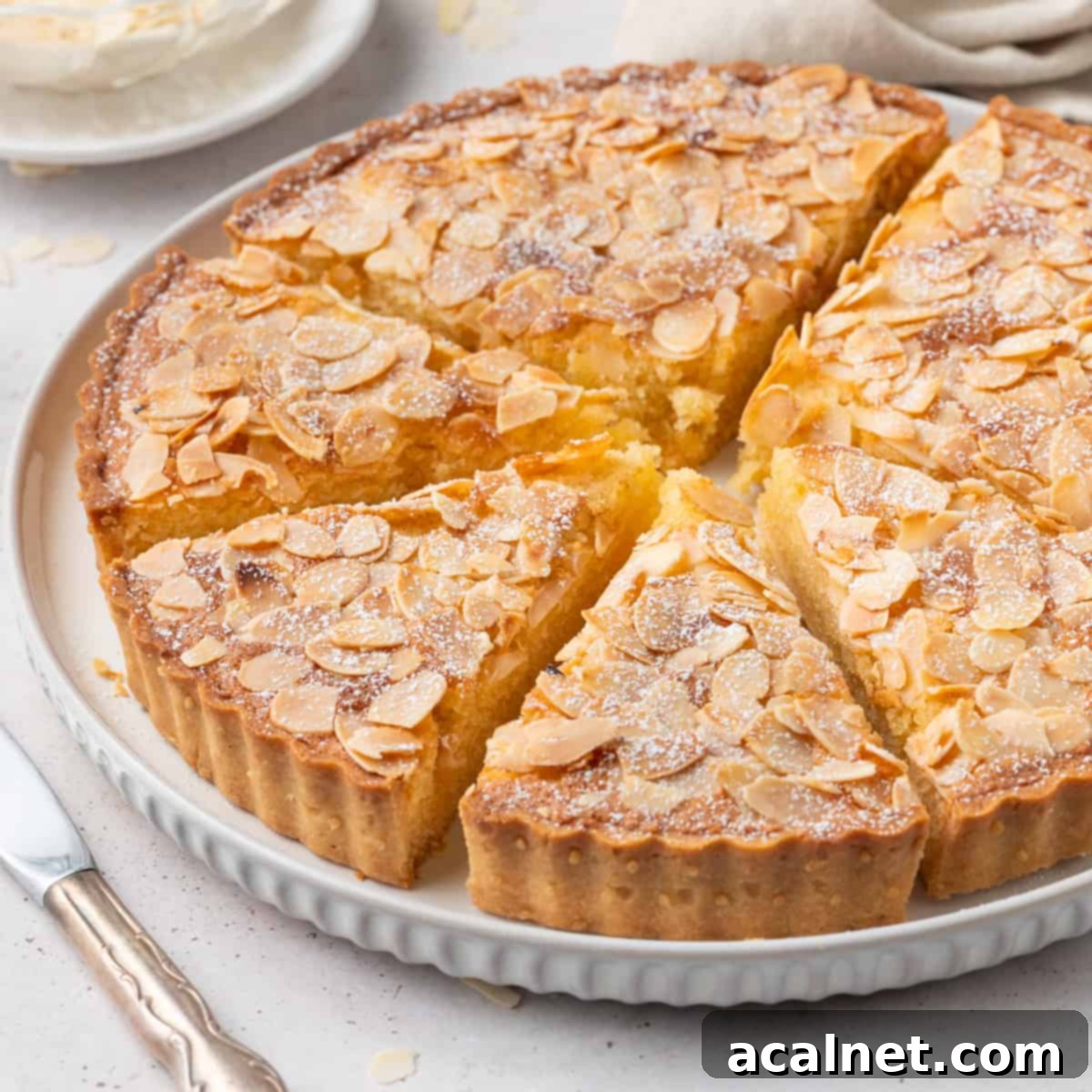
This delectable tart is truly a celebration of almond flavor. Its perfect balance of buttery, flaky crust, a rich, fragrant almond sponge, and a delightful crunch from toasted flaked almonds on top makes it an undeniable crowd-pleaser. Every bite offers just the right amount of sweetness, a deeply nutty aroma, and a melt-in-your-mouth texture that is simply unforgettable. While wonderful on its own, this versatile dessert can also be adapted with various fruits, adding another layer of complexity and taste. Explore some of our other delightful frangipane tart variations below:
- Apricot Almond Tart
- Apple Almond Tart
- Raspberry Frangipane Tartlets
- Pear Almond Tart (Bourdaloue Tart)
- Peach Almond Tart
- Mini Pear Frangipane Tart
Understanding the Frangipane Tart
A Frangipane Tart is a quintessential French dessert, deeply rooted in classic pastry traditions. At its heart, it consists of a sweet shortcrust pastry (Pâte Sucrée) that serves as the foundation for a rich, baked almond cream filling. When this tart is prepared simply, with just the almond cream, it’s specifically known as an “Amandine Tart.” However, its versatility allows for endless variations, often enhanced with fresh or poached fruits that complement the almond flavor beautifully.
The term “frangipane” itself can sometimes be a source of confusion, as it refers both to the dessert and to a specific type of almond cream filling. In the strictest sense of classic French Pâtisserie, a true frangipane cream is a blend of traditional almond cream and light, silky crème pâtissière (pastry cream). This combination yields an even more delicate and nuanced texture. For our Tarte Amandine, we primarily use a pure almond cream, which still delivers that beloved nutty flavor and tender crumb, making it an accessible yet authentic French baking experience.
Key Ingredients for Your Almond Tart
Crafting the perfect French Almond Tart begins with selecting the right ingredients. Each component plays a vital role in achieving the desired texture, flavor, and overall excellence of this classic dessert. Below, we’ll dive into what makes up our delicious almond frangipane tart.
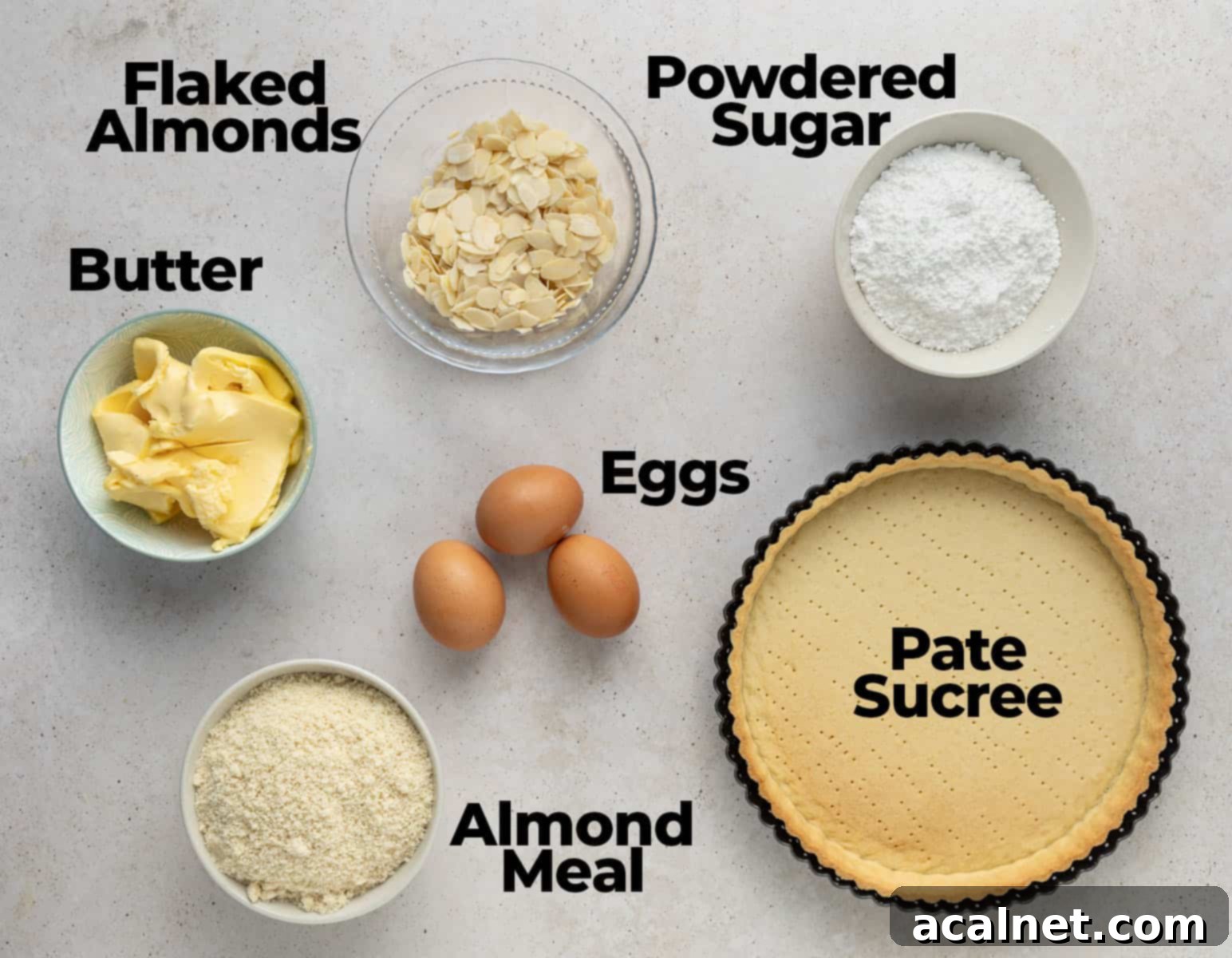
For precise quantities, please refer to the comprehensive recipe card below.
For the Sweet Shortcrust Pastry (Pâte Sucrée):
- Dry Ingredients: A precise blend of fine Almond Meal (or Almond Flour) provides a tender, nutty texture to the crust, complementing the filling. This is combined with Plain / All-Purpose Flour to give structure and a crucial pinch of Fine Salt to balance the sweetness.
- Wet Ingredients: Ensure you use very soft unsalted Butter, as its temperature is critical for a smooth dough. Powdered Sugar (also known as Icing Sugar or Confectioner’s Sugar) lends delicate sweetness and contributes to the pastry’s crispness. A large Egg, at room temperature, binds the ingredients together, creating a pliable dough.
For the Almond Cream Filling:
- Butter: Unsalted and very soft, at room temperature. The softness is key for creaming properly with sugar, ensuring a light and airy base for the cream.
- Sugar: Powdered Sugar (Confectioner’s Sugar or Icing Sugar) is preferred for its fine texture, which dissolves smoothly into the butter, resulting in a perfectly creamy filling without graininess.
- Eggs: Use large eggs, also at room temperature. The temperature synchronization between butter and eggs is vital; cold eggs can cause the butter to seize and the mixture to split. A good rule of thumb in French pastry is to aim for equal weights of eggs, butter, and almond meal for optimal consistency.
- Almond Meal: You can choose between blanched or un-blanched almond meal, made from coarsely ground almonds. Almond flour, which is finer, will also work, but it tends to produce a slightly denser filling with less of the subtle crunch that coarsely ground meal provides.
For an enhanced flavor profile, consider adding a dash of Almond Extract or Vanilla Extract to the almond cream. These extracts amplify the natural nutty notes and add aromatic depth.
To Finish:
- Flaked Almonds: These are essential for adding a beautiful visual appeal and an irresistible crunch and texture to the top of your tart. If flaked almonds aren’t available, slivered almonds or even roughly chopped almonds can be used as a substitute.
- Icing Sugar: An optional, yet elegant, dusting of icing sugar (powdered sugar) just before serving adds a professional touch and an extra hint of sweetness.
Crafting Your French Almond Tart: A Step-by-Step Guide
Follow these detailed steps to create a show-stopping French Almond Tart that’s as delightful to make as it is to eat. Precision and patience are your best friends in pastry making!
1. Preparing the Pâte Sucrée Tart Shell
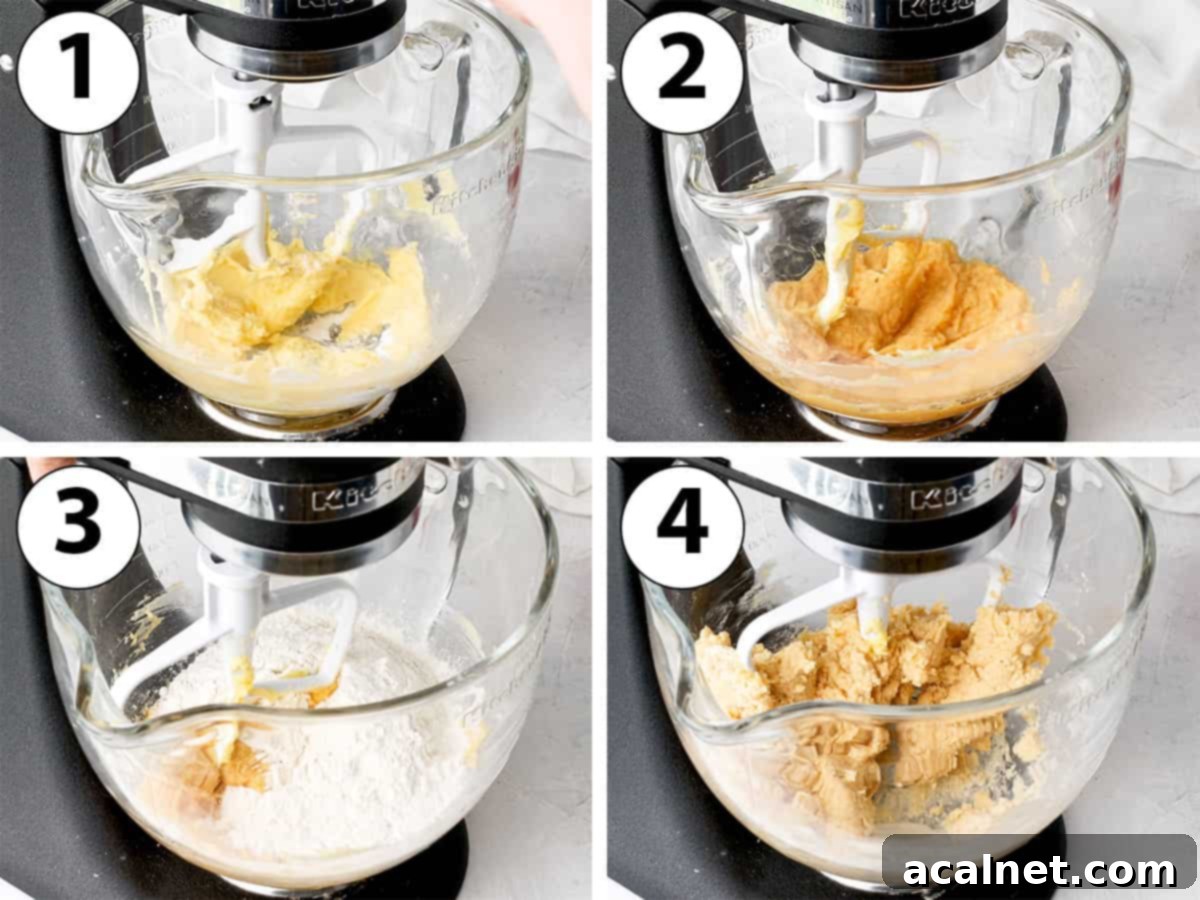
- Photo 1: Begin by creaming the butter and sugar. Place your very soft unsalted butter and sifted powdered sugar into the bowl of a stand mixer fitted with a paddle attachment. If you’re using a hand mixer, a large mixing bowl will suffice. Cream these ingredients together on medium speed for approximately 2 to 3 minutes, or until the mixture becomes wonderfully smooth, light, and homogenous. This step incorporates air, contributing to the pastry’s delicate texture.
- Photo 2: Next, incorporate the egg and almond meal. Add the room temperature egg and the almond meal to the butter-sugar mixture. Continue to mix until all ingredients are well combined. Remember to stop and scrape down the sides of the bowl periodically to ensure everything is evenly incorporated. At this stage, you should have a thick, slightly lumpy, yet cohesive mixture.
- Photo 3: Introduce the remaining dry ingredients. Gently add the sifted plain/all-purpose flour and the pinch of fine salt to the bowl. Sifting the flour prevents lumps and ensures an even distribution.
- Photo 4: Mix just until combined. Switch your mixer to a low speed and mix only until a rough dough just begins to come together. It’s crucial to avoid over-mixing the pastry once the flour is added, as this can develop the gluten too much, leading to a tough and chewy crust rather than a tender, flaky one. The dough should still look a bit crumbly but should hold together when pressed between your fingers.
For a truly traditional French pastry experience, after the flour is added and the dough is roughly formed, a technique called “fraisage” (or “frasage“) can be performed. This involves gently pressing and spreading the dough across your working surface with the palm of your hand, then gathering it back up and repeating the process a few times. This helps to create a perfectly smooth, homogeneous dough without overworking the gluten, ensuring a tender and crisp final product.
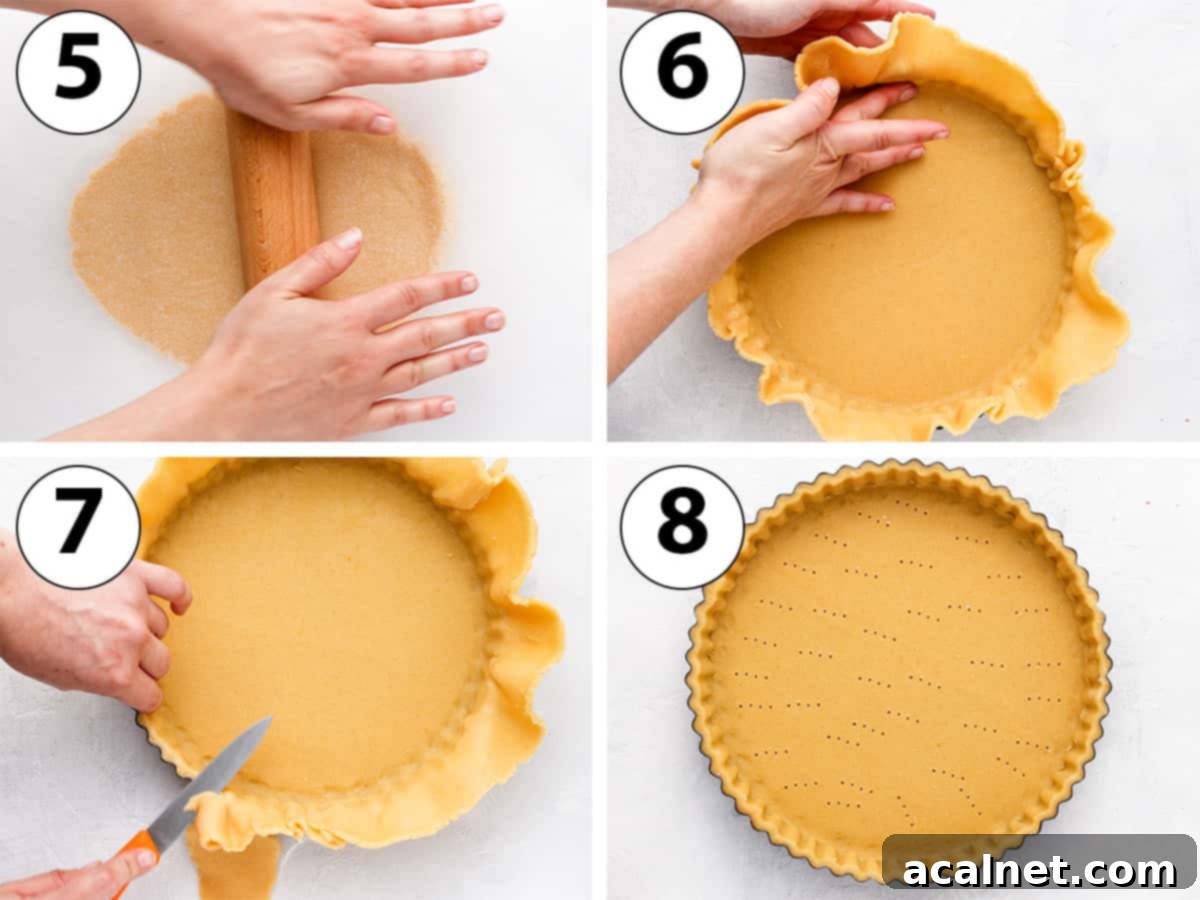
- After forming, place the pastry dough between two sheets of baking paper (parchment paper) and gently flatten it with your palm to create a thick disk. This makes it easier to roll.
- Photo 5: Roll the pastry evenly. Using a rolling pin with thickness rings or thickness strips is highly recommended to achieve a consistent thickness of about 4 mm (1/6 inch). This uniformity is key for even baking. Once rolled, place the flat pastry (still between the parchment paper) onto a large baking sheet and chill it in the refrigerator for at least 1 hour, or ideally for up to 24 hours. The dough must be very cold and firm before handling.
- Photo 6: Prepare your tart pan. Carefully remove the baking paper from the chilled dough and transfer it over a 24 cm (9.5-inch) tart tin. A tart tin with a removable bottom is highly recommended for easy demolding. Gently press the pastry down into the corners of the tart tin, ensuring it forms a crisp 90-degree angle between the bottom and the sides. Don’t worry if the pastry cracks a little; it can easily be patched up by pressing with your fingertips.
If your pastry is too cold and rigid to handle, allow it to sit at room temperature for a few minutes to soften slightly. Conversely, if it becomes too soft and difficult to work with, return it to the fridge for a few minutes to firm up.
- Photo 7: Trim and rest. Using a small paring knife, carefully cut off any excess dough hanging over the edge of the tart pan. Once trimmed, place the tart pan back into the fridge to chill and rest for at least 3 hours, or preferably overnight (up to 24 hours). This crucial resting period prevents the pastry from shrinking during baking and ensures a beautifully crisp crust.
- Photo 8: Prepare for par-baking. Preheat your oven to 160°C (325°F). Before baking, “dock” the pastry by pricking the bottom of the tart shell all over with a fork. This allows steam to escape, preventing the crust from puffing up. Place the docked pastry in the freezer while the oven preheats (about 15 minutes) for an extra layer of chilling, which further helps maintain its shape.
- Par-bake the crust. Bake the tart shell for 16 to 18 minutes, or until the bottom feels dry to the touch. This step is essential to prevent a soggy crust once the filling is added. Transfer the par-baked crust to a wire rack and allow it to cool down completely before proceeding.
A note on par-baking: I typically do not use baking weights to par-bake this pastry. If the dough has been properly chilled and rested for the recommended times, it should hold its shape well in the oven. Avoiding weights also means the bottom of the crust is exposed to the heat, allowing it to dry out as much as possible, which is key for a crispy base before the filling is added.
2. Crafting the Almond Cream Filling
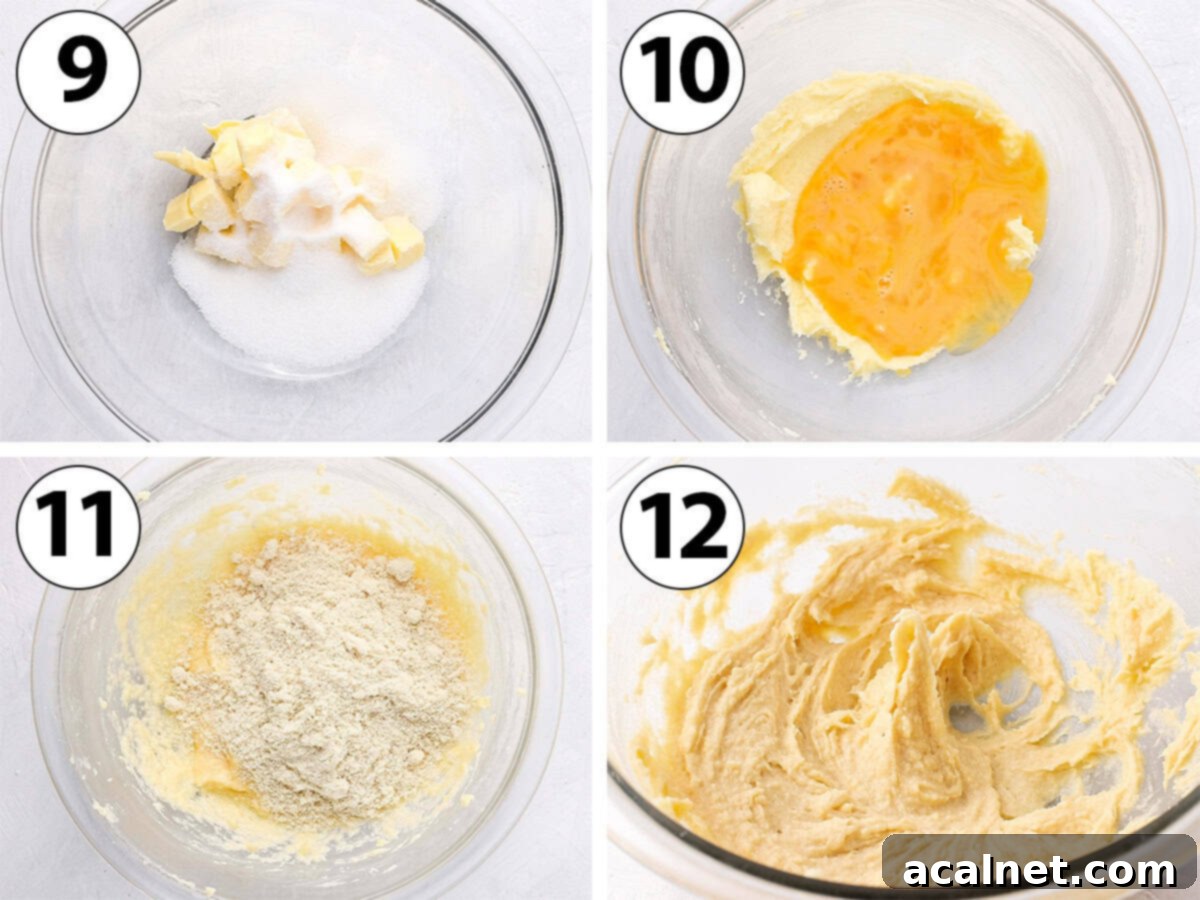
- Photo 9: Cream the butter and sugar. In a large mixing bowl (or the bowl of your stand mixer with the paddle attachment), combine the very soft unsalted butter and powdered sugar. Cream them together on medium speed for about 3 to 5 minutes. The mixture should become incredibly soft, noticeably creamy, and almost doubled in volume, indicating sufficient aeration.
- Photo 10: Gradually add the eggs. Incorporate the room temperature eggs one at a time, mixing slowly until each egg is fully combined before adding the next. This step is crucial for maintaining the emulsion.
It’s quite common for the mixture to appear as though it’s splitting or curdling at this stage. This usually happens if your butter or eggs were too cold or too warm. Don’t be alarmed; this is a common occurrence and the mixture will miraculously come back together once you add the almond meal, so continue with confidence!
- Photo 11 & 12: Fold in the almond meal. Add the almond meal to the creamy mixture and slowly mix it in until you achieve a thick, coarse, yet spreadable paste. Over-mixing here can also affect the final texture, so mix just until combined.
If your almond cream appears a bit greasy, it’s often a sign that the butter was too warm. To rectify this, you can chill the cream in the refrigerator for up to 15 minutes to help it firm up slightly. If chilling for a longer period, remember to allow it to soften at room temperature for a short while before attempting to spread it into the tart crust.
3. Assembling and Baking Your Tart
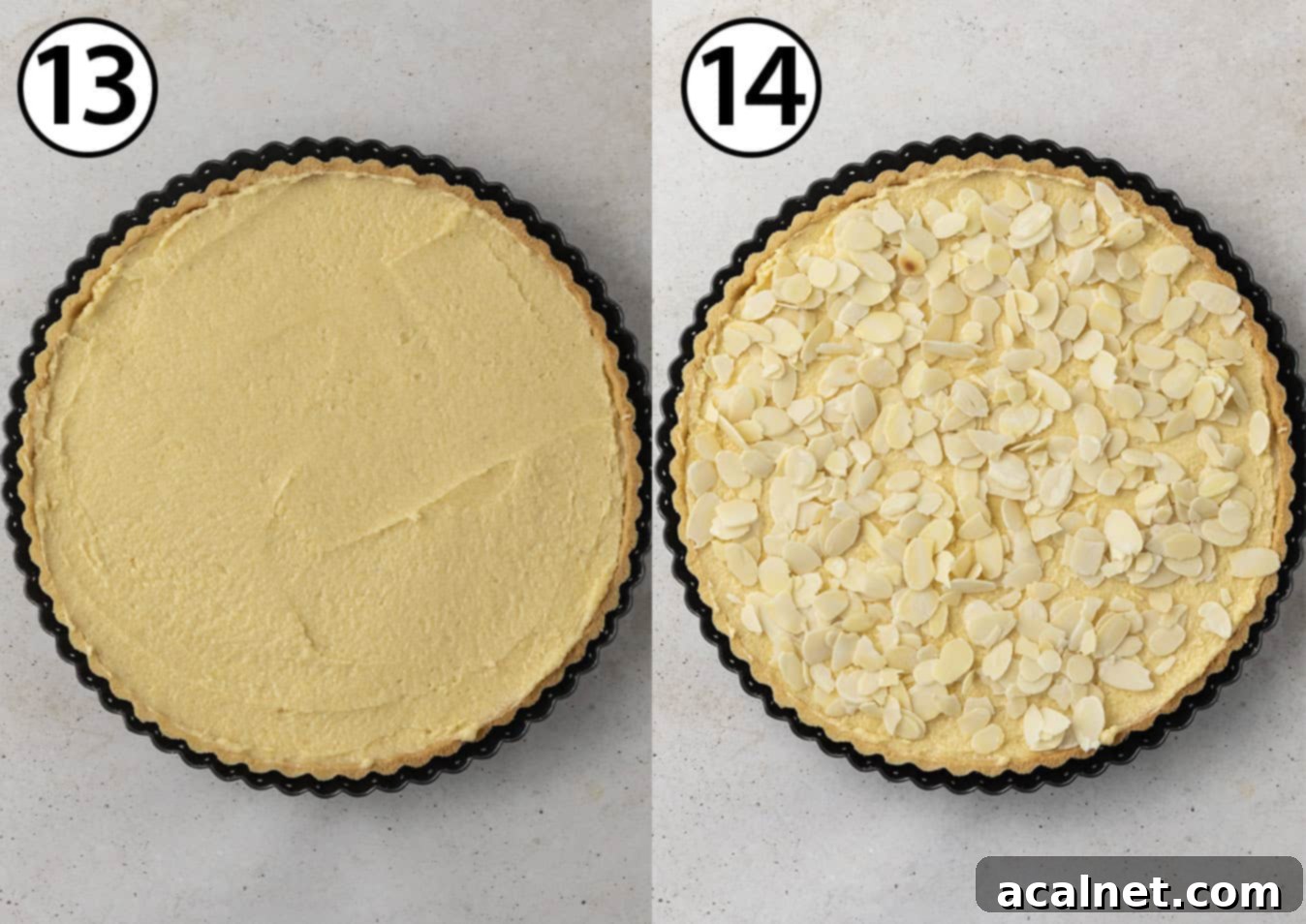
- Ensure your oven is preheated to 160°C (325°F) if it has cooled down.
- Photo 13: Fill the tart shell. Transfer the prepared almond cream filling into the par-baked tart crust. You can achieve this neatly using a piping bag, or simply use a spatula or the back of a spoon to scoop and spread the cream. Use a small offset spatula to spread the cream into an even layer, ensuring it reaches all edges without overflowing.
- Photo 14: Add the almond topping. Generously sprinkle the flaked almonds evenly over the entire surface of the frangipane cream. This step adds both visual appeal and a wonderful textural contrast.
- Bake the tart. Place the filled tart into your preheated oven and bake for approximately 30 to 40 minutes. The tart is ready when the almond sponge has puffed up, feels firm to the touch (set), and the flaked almonds on top have turned a beautiful golden brown.
If you notice the tart crust browning too quickly during baking, it might indicate that your oven temperature is running a bit high. In this case, gently lower the oven temperature by 10-15°C (25-30°F) and continue baking until the filling is fully set and golden.
- Once baked, remove the tart from the oven and place it on a wire rack to cool down completely. This allows the filling to fully set and makes it easier to remove from the tart pan. For an extra touch of elegance, dust the cooled tart with icing sugar just before serving.
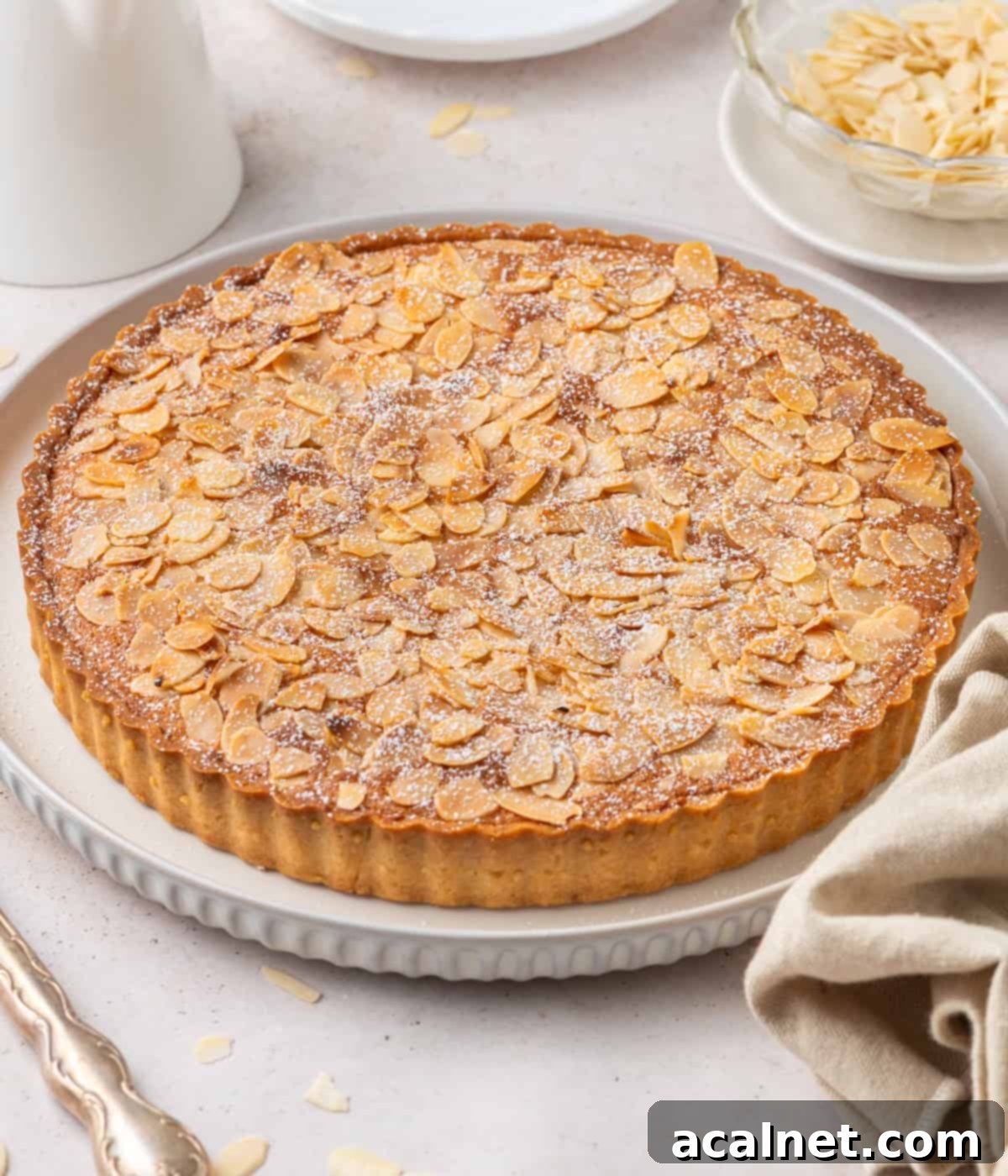
Frequently Asked Questions About Almond Tart
Absolutely! This almond tart recipe is incredibly versatile and welcomes various flavor additions. For a deeper, earthier flavor profile, you can easily replace the almond meal with hazelnut meal. Spices like cinnamon, nutmeg, cardamom, or even a hint of ginger can be incorporated into the almond filling for an aromatic twist. To create a classic Bakewell Tart, simply spread a layer of your favorite jam (raspberry or strawberry works wonderfully) under the almond cream. For a delightful fruity touch, top the almond filling with fresh or poached fruits such as strawberries, blueberries, raspberries, or sliced pears before baking.
In the precise world of traditional French pastry, almond cream and frangipane cream are distinct, though often conflated. Almond Cream, as used in this recipe, is a rich, sponge-like filling made from equal parts (by weight) of butter, sugar, eggs, and ground almond. It’s a foundational component that bakes beautifully into tarts, pastries (like almond croissants), and cakes. Frangipane Cream, on the other hand, is a more elaborate preparation. It is created by combining this rich almond cream with a light and smooth crème pâtissière (pastry cream). This mixture is famously used in grander desserts like the “Galette des Rois” cake, offering a lighter, more complex texture. The general public often refers to any dessert with an almond cream filling as “frangipane,” leading to the common confusion.
While all three are almond-based, they have distinct compositions and uses:
– Frangipane (or almond cream) is a baked, sponge-like cream. It’s made from butter, sugar, eggs, and ground almonds, and its primary use is as a delicious, moist filling that sets during baking.
– Almond Paste is a much denser, less sweet mixture typically made from finely ground almonds and sugar, often with a small amount of liquid or egg white. It has a relatively coarse texture and is commonly used as an ingredient in other baked goods, or as a dense, chewy filling for pastries. It does not contain butter and usually isn’t baked on its own.
– Marzipan is a smooth, sweet, pliable confection also made from ground almonds and sugar, but with a much higher sugar content and a very fine, paste-like consistency. It’s often flavored with almond extract. Marzipan can be molded into various decorative shapes, rolled out to cover cakes, or used as a sweet filling without needing further baking, as its texture is already complete.
Knowing when your almond cream filling is perfectly cooked is key to a successful tart. The most reliable indicators are visual and tactile. The almond cream should have visibly risen and appear slightly puffed in the center. Its surface will have achieved a beautiful golden-brown color, and when gently pressed with a fingertip, it should feel spongy and set, not liquid or wobbly. It’s crucial to bake the tart at a moderate temperature (like the 160°C/325°F recommended) to allow the filling to cook through evenly without the butter melting too rapidly, which could lead to a greasy, soggy filling rather than a light, flavorful sponge.
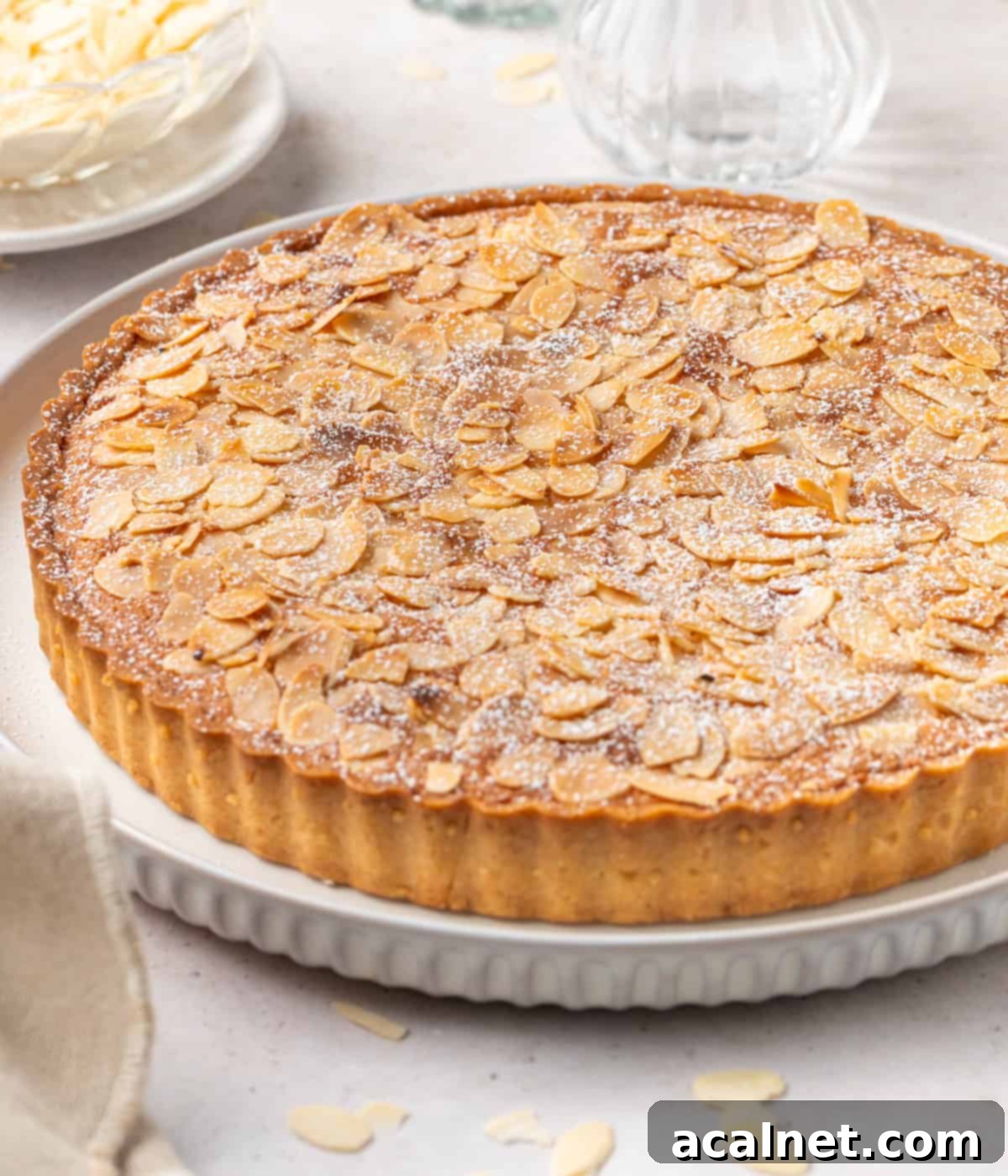
Expert Tips & Troubleshooting for Perfect Results
- Achieving Even Pastry Thickness: For a crust that bakes uniformly and looks professional, I highly recommend using a rolling pin with thickness rings or a set of thickness strips. These tools ensure your Pâte Sucrée is rolled to a consistent 4mm (1/6 inch) across its entire surface, which is crucial for even cooking and preventing thin, burnt spots or thick, underbaked areas.
- The Importance of Chilling and Resting: This is arguably the most critical step for a perfect tart crust. Proper chilling and resting allow the butter in the pastry to firm up completely, preventing it from melting too quickly in the oven and causing the crust to shrink. Moreover, it gives the gluten developed during mixing time to relax, resulting in a tender, melt-in-your-mouth texture rather than a tough one. Make sure to chill your pastry twice: first after rolling it out, and then for several hours (preferably overnight or up to 24 hours) after lining your tart pan. This double chilling ensures maximum stability and crispness.
- Choosing the Right Tart Pan: For superior results, invest in a perforated tart pan with a removable bottom plate. The perforations allow hot air to circulate freely around the entire crust, promoting even baking and ensuring the bottom of your tart shell gets beautifully crisp. The removable bottom, of course, makes demolding your delicate tart incredibly easy without damaging it.
- Preventing Almond Cream from Splitting: If your almond cream mixture separates or curdles when you add the eggs, it’s almost always an indication that there’s a significant temperature difference between your ingredients. To prevent this, ensure all your ingredients, especially the butter and eggs, are at room temperature. When butter is too cold, it won’t emulsify properly with the eggs, causing chunks. If butter is too warm, it can become greasy and separate. Consistency in temperature is key for a smooth, homogenous almond cream.
Storing and Freezing Your Almond Tart
This delightful almond tart can be kept at room temperature for up to one day, making it a convenient option for entertaining. For longer storage and to maintain its freshness, it’s best to store the tart in the refrigerator, where it will remain delicious for up to 3 days. Always cover it loosely with plastic wrap or foil to prevent it from drying out.
While you’ll undoubtedly experience the best flavor and texture when serving the tart fresh, it can also be successfully frozen for future enjoyment. To freeze, ensure the tart is completely cooled. Place it on a flat tray and freeze until solid. Once frozen, wrap it tightly first in a layer of plastic wrap, followed by a layer of aluminum foil. This double layer of protection helps prevent freezer burn. When you’re ready to enjoy it, simply thaw the tart in the refrigerator overnight or at room temperature for a few hours. For a warmed experience, you can gently reheat thawed slices in a low oven.
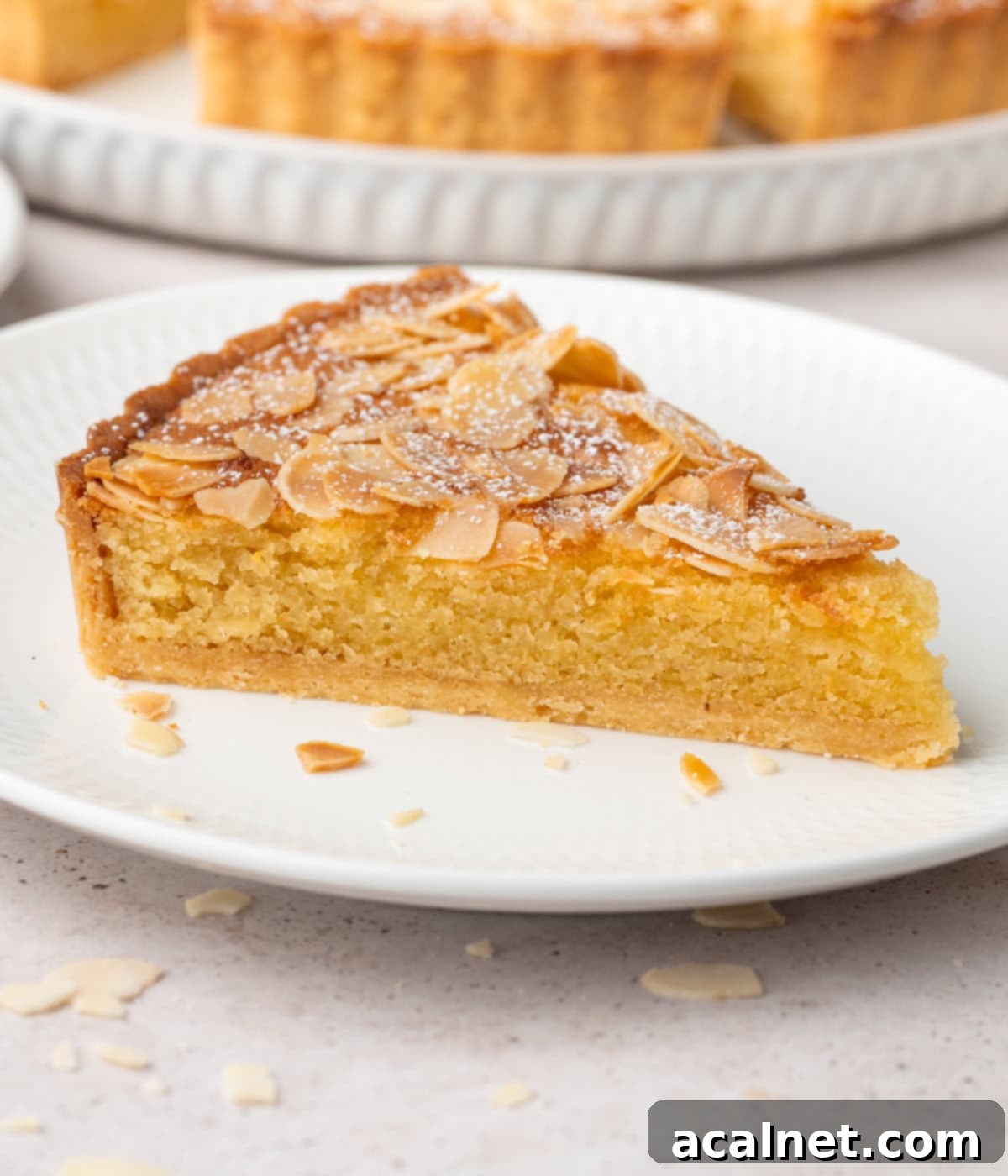
Explore More Delicious Tart Recipes
- Rich French Chocolate Ganache Tart
- Sweet Strawberry Custard Tart
- Vibrant Raspberry Tart
- Simple French Apple Tart
- Indulgent Chocolate Raspberry Tart
- Zesty French Orange Tart
- Tropical Passion Fruit Tart
- Nutty Pistachio Tart
I am so excited to share that my debut cookbook
“Bite-Sized French Pastries for the Beginner Baker”
is now available for purchase!
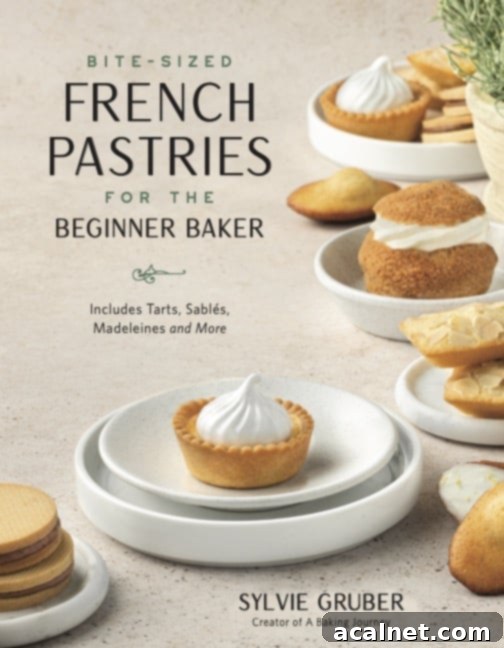
Full Recipe Details

French Almond Tart
Servings: 10
Author: Sylvie
Print Recipe
Ingredients
Pâte Sucrée Crust
- 100 gr Unsalted Butter, at room temperature
- 50 gr Powdered Sugar, sifted
- 1 large Egg, at room temperature
- 40 gr Almond Meal, or almond flour
- 200 gr Plain / All-Purpose Flour
- 1 pinch Fine Table Salt
Almond Cream (Frangipane)
- 150 gr Unsalted Butter, at room temperature
- 150 gr Powdered Sugar, sifted
- 3 large Eggs, at room temperature
- 150 gr Almond Meal, or almond flour
- 50 gr Flaked Almonds
Instructions
Pâte Sucrée Crust
- Place the soft butter and sifted powdered sugar in a large bowl. With a mixer, cream on medium speed for 2 to 3 minutes or until completely smooth.
- Add the egg and almond meal and mix until well combined. Stop to scrape the side of the bowl when required. You should get a thick, slightly lumpy mixture.
- Add sifted flour and salt, and slowly mix until a rough dough comes together (see note 1). If you press the crumbs between your fingers, they should easily stick and combine into a smooth dough.
- Place the pastry between two sheets of baking paper / parchment paper and flatten it with your palm to get a thick disk.
- Roll the pastry to a thickness of about 4 mm or 1/6 inch (see note 2). Place the flat pastry on a large baking sheet and chill for at least 1 hour (or up to 24 hours). It should be very cold and hard.
- Remove the baking paper and transfer the dough over a 24 cm (9,5-inch) tart tin, preferably with a removable bottom. Gently press the pastry down into the corner of the tart tin to create a 90-degree angle. If it cracks, you can patch it up with your fingertips (see note 3).
- Cut off any excess dough with a small pairing knife. Place the tart pan in the fridge to chill and rest for at least 3 hours, preferably overnight (or for up to 24 hours).
- Preheat your oven on 160 degree Celsius / 325 degree Fahrenheit. Dock the pastry (prick the bottom of the pastry with a fork) then place in the freezer while the oven is preheating (about 15 minutes).
- Par-bake for 16 to 18 minutes or until the bottom feels dry to the touch (see note 4). Place on a wire rack and leave to cool down completely.
Almond Cream (Frangipane)
- Place the very soft butter and sugar in a large size bowl. With a mixer, cream on medium speed for about 3 to 5 minutes or until very soft, creamy and almost doubled in volume.
- Add the eggs one at the time, slowly mixing it into the butter until fully incorporated (see note 5).
- Add the almond meal and slowly mix in to get a thick, coarse paste (see note 6).
Assembling the tart
- If needed, re-heat your oven on 160 degrees Celsius / 325 Fahrenheit.
- Transfer the almond cream over the par-baked tart crust. You can use a piping bag or simply a spatula / back of a spoon. With a small offset spatula, spread the cream into an even layer.
- Sprinkle the flaked almond all over the almond cream.
- Bake the filled tart for about 30 to 40 minutes or until the almond sponge has puffed and set and the almonds on top look golden brown.
- Rest on a wire rack to cool down completely before removing from the tart pan. Optionally, dust with icing sugar before serving.
Would you like to save this recipe?
We’ll email this post to you, so you can come back to it later!
Notes
- Make sure not to over-mix the pastry to avoid creating too much gluten, which will make your dough pull and shrink when rolled. Traditionally, a technique called “fraisage” (or “frasage“) is done after the addition of flour. The tart dough is placed on your working surface. With the palm of the hand, the dough is gently pressed and pushed out, picked back up and spread out again until very smooth.
- For the best results, use a rolling pin with thickness rings or thickness strips to get an evenly rolled pastry.
- If the pastry is too cold and hard to be handled, leave it for a few minutes at room temperature to soften. If it gets too soft, place back in the fridge for a few minutes.
- I do not use any weight to par-bake the pastry. If it has been properly chilled and rested, it should not move in the oven. You actually want to avoid covering the bottom so it can dry out as much as possible before adding the filling.
- The mixture often starts to split at this point. This can happen if your butter was too cold or your eggs were too cold or warm. Don’t worry if this happens, the almond filling will come back together once you add the almond meal.
- If the cream appears to be a bit greasy, it is usually an indication that the butter is too warm. You can chill the cream for up to 15 minutes before using in the tart crust to firm it up/ If chilling for longer, allow to soften at room temperature first to make it easier to spread.
Nutrition (per serving)
Made this recipe?
Let us know if you liked it by leaving a comment below, and tag us on Instagram @a.baking.journey with a photo of your creation!
